From the Trenches
Mesopotamian Accounts Receivable
By SAMIR S. PATEL
Monday, February 10, 2014
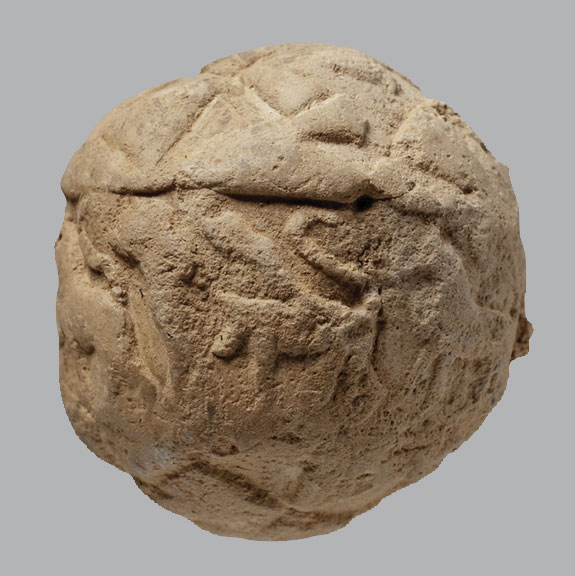 It was surely hard to keep accurate accounts before writing was developed, but Mesopotamian merchants found a way in the form of clay balls that researchers call “envelopes,” filled with tokens and impressed with seals. Dozens of these envelopes have been found, but deciphering their meaning is problematic—broken ones are difficult to reconstruct accurately and, until recently, intact ones could not be studied without first breaking them.
It was surely hard to keep accurate accounts before writing was developed, but Mesopotamian merchants found a way in the form of clay balls that researchers call “envelopes,” filled with tokens and impressed with seals. Dozens of these envelopes have been found, but deciphering their meaning is problematic—broken ones are difficult to reconstruct accurately and, until recently, intact ones could not be studied without first breaking them.
Sumerologist Christopher Woods and his team from the Oriental Institute at the University of Chicago are now using CT scans to peer inside 18 intact envelopes that date to more than 5,000 years ago, excavated from Choga Mish in Iran in the 1960s and 1970s. The team observed that the tokens come in a variety of shapes and sizes, and sometimes have surface incisions, all of which could represent different commodities or amounts. “If the contents [of a transaction] were contested,” Woods writes, “the envelope could be broken open and the tokens verified.” The balls also have seal impressions around the middle and on each end, which might represent the identities of buyers, sellers, or witnesses to a transaction. More scans will help researchers build a corpus of envelopes that can be deciphered. “We are now at a point in terms of technology where we can collect more and better data using nondestructive methods than we could if we physically opened the balls,” according to Woods.
Triangulating Buddha's Birth
By NIKHIL SWAMINATHAN
Monday, February 10, 2014
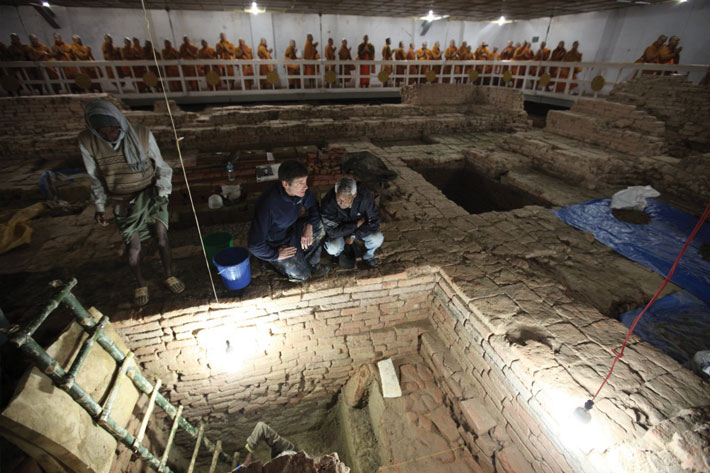
Buddhist scholars and devotees are split into two camps over when Buddha was born, in large part because the sage’s birth preceded formal writing by several centuries. Some say the mid-sixth to seventh century b.c., while others believe it was later, in the mid- to late fourth century B.C. What they do agree upon is his birthplace: Lumbini, Nepal.
Archaeologists working at Lumbini have now uncovered evidence that appears to support the earlier birth date. Digging within the grounds of the Maya Devi Temple, named after Buddha’s mother, the team unearthed a succession of temples carefully oriented to re-create the cosmos and place Buddha at its center. The oldest, which would have been outlined in timbers, dates to the sixth century B.C.
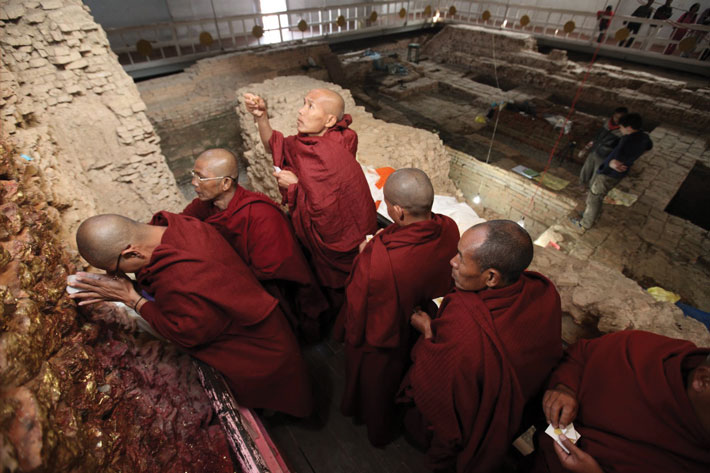 The timber temple sits beneath a newer brick structure dating to the third century B.C. that was built by Ashoka, a proselytizer of Buddhism and ruler of the Mauryan Empire that held most of South Asia at the time. Archaeologists found root features at the center of the Ashokan temple, evidence that it was built around a sacred Bodhi Tree, a common feature of Buddhist shrines that symbolizes enlightenment. The team believes the timber structure was built around one as well. “Our sequence starts in the sixth century B.C., with the creation of a sacred space around a tree, and this pattern is later replicated twice,” says lead archaeologist Robin Coningham of the University of Durham. “The earlier structures were not destroyed, but were carefully enshrined one under another, indicating the importance of preserving that continuity.”
The timber temple sits beneath a newer brick structure dating to the third century B.C. that was built by Ashoka, a proselytizer of Buddhism and ruler of the Mauryan Empire that held most of South Asia at the time. Archaeologists found root features at the center of the Ashokan temple, evidence that it was built around a sacred Bodhi Tree, a common feature of Buddhist shrines that symbolizes enlightenment. The team believes the timber structure was built around one as well. “Our sequence starts in the sixth century B.C., with the creation of a sacred space around a tree, and this pattern is later replicated twice,” says lead archaeologist Robin Coningham of the University of Durham. “The earlier structures were not destroyed, but were carefully enshrined one under another, indicating the importance of preserving that continuity.”
Game of Stones
By NIKHIL SWAMINATHAN
Monday, February 10, 2014
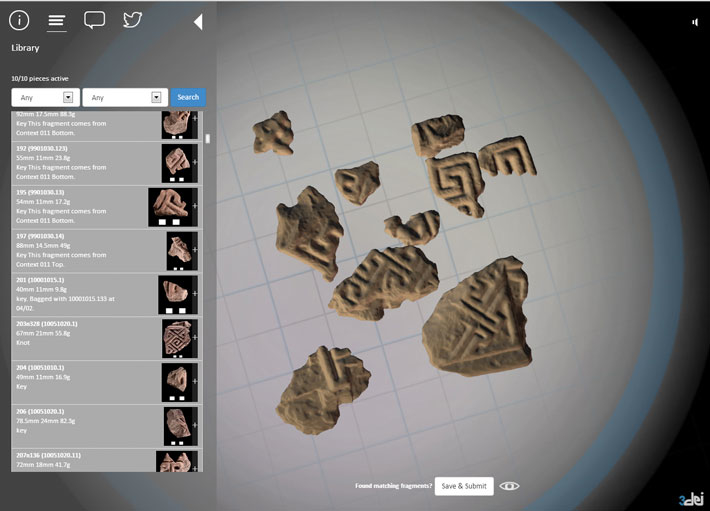 In the seventeenth century, the 1,200-year-old Hilton of Cadboll Stone had a great fall. Now, National Museums Scotland (NMS) is enlisting video game players to help put it together again.
In the seventeenth century, the 1,200-year-old Hilton of Cadboll Stone had a great fall. Now, National Museums Scotland (NMS) is enlisting video game players to help put it together again.
The sandstone slab was carved by the Picts of northern Scotland around A.D. 800, likely to celebrate their conversion to Christianity. In the 1670s, a storm toppled it and a cross emblazoned on one side was damaged. Originally discovered in 2001, the bottom portion of the 7.5-foot-tall stone was in 3,000 pieces, ranging in size from two to eight inches. Reassembling it by hand would prove a daunting task.
Enter the techies. A Scottish company called Relicarte has transformed the fragments into 3-D virtual objects and made them available to the public in a special application. Starting in late October 2013, gamers could use their spatial reasoning skills to reassemble the slab. “The ability to manipulate 3-D images easily and interact over social media is key,” says Mhairi Maxwell, an NMS curator. “Archaeology has always had to draw upon a diverse range of skill sets for understanding the past—it is both an art and a science.” The researchers don’t know how long the process will take, but it will certainly be faster than the old-fashioned way.
How to Pray to a Storm God
By ERIC A. POWELL
Monday, February 10, 2014
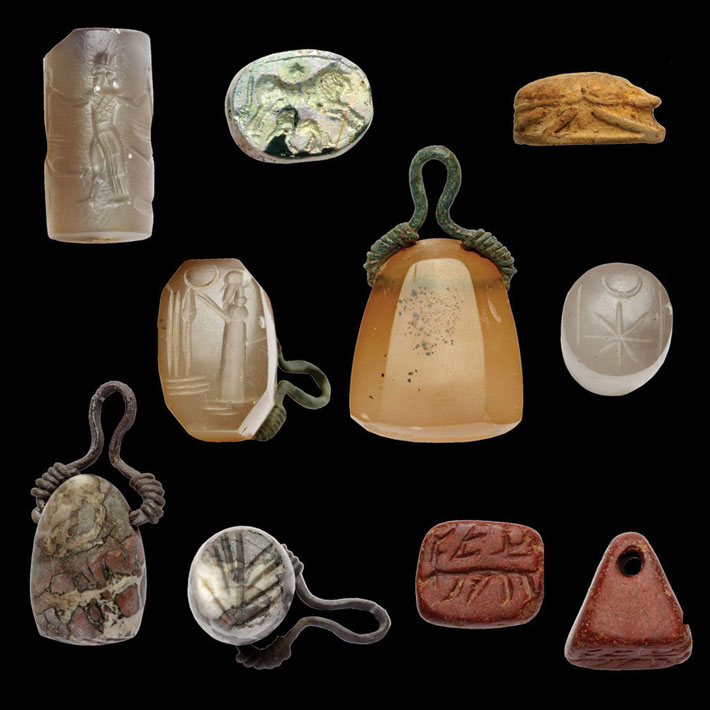
Archaeologists excavating an ancient mountaintop sanctuary in southeastern Turkey have unearthed more than 600 seals and amulets left at the temple as votive offerings. Originally dedicated to a Near Eastern storm god, the sanctuary was in use from the first millennium B.C. until the seventh century A.D. But around 200 B.C., the temple was rebuilt, a process that sealed off the site’s older layers and protected the objects intentionally left behind by generations of worshippers seeking the storm god’s help. Dating from the seventh to fourth centuries B.C., the artifacts come from all over the Near East and depict both simple geometric symbols and intricate scenes of men praying. Some show a royal hero in the midst of fighting animals or mythical creatures. University of Münster archaeologist Englebert Winter says worshippers would have worn the amulets in everyday life to ward off evil, and that offering them to the storm god was an intensely personal pious act. “People consecrated to the god an object that was closely associated with their own identity,” says Winter.
Scuttled but Not Forgotten
By SAMIR S. PATEL
Monday, February 10, 2014
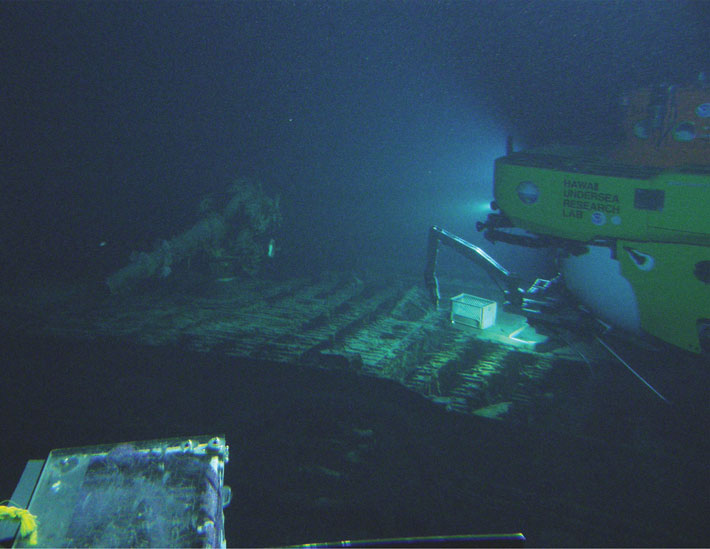 Nearly half a mile beneath the surface of the Pacific, southwest of Oahu, lie massive remains tied to a stunning tale from the last days of World War II and the first days of the Cold War that followed. Archaeologists using Pisces V, a manned submersible operated by the Hawaii Undersea Research Laboratory, found the wreck of I-400, a Japanese submarine remarkable not only for its size (400 feet long, twice that of a German U-boat), but also for its capabilities (it held three aircraft with folding wings that could be launched by catapult) and mission (its crew trained to attack the Panama Canal). Following the end of hostilities in the Pacific, the Allies had agreed to share military technology seized from Japanese forces. But I-400 and its sister vessels were simply too advanced and important—the United States scuttled the ships rather than share their secrets with the Soviets.
Nearly half a mile beneath the surface of the Pacific, southwest of Oahu, lie massive remains tied to a stunning tale from the last days of World War II and the first days of the Cold War that followed. Archaeologists using Pisces V, a manned submersible operated by the Hawaii Undersea Research Laboratory, found the wreck of I-400, a Japanese submarine remarkable not only for its size (400 feet long, twice that of a German U-boat), but also for its capabilities (it held three aircraft with folding wings that could be launched by catapult) and mission (its crew trained to attack the Panama Canal). Following the end of hostilities in the Pacific, the Allies had agreed to share military technology seized from Japanese forces. But I-400 and its sister vessels were simply too advanced and important—the United States scuttled the ships rather than share their secrets with the Soviets.
Advertisement
Advertisement
IN THIS ISSUE
Features
Saving the Villa of the Mysteries
All Hands on Deck
Messengers to the Gods
Letter From Borneo
From the Trenches
Our Tangled Ancestry
Off the Grid
Viking Finery
Scuttled but Not Forgotten
Game of Stones
How to Pray to a Storm God
Triangulating Buddha's Birth
Mesopotamian Accounts Receivable
Barbarian Body Modification
Did Neanderthals Bury Their Dead?
Florida History Springs Forth
Turtle Power
Battle of the Proxies
World Roundup
Aztec god of the dead, gold in Lake Titicaca, Anglo-Saxon gaming piece, and building the Forbidden City
Artifact
The importance of music in Peru
Advertisement

Recent Issues
-
 May/June 2024
May/June 2024
-
 March/April 2024
March/April 2024
-
 January/February 2024
January/February 2024
-
 November/December 2023
November/December 2023
-
 September/October 2023
September/October 2023
-
 July/August 2023
July/August 2023
-
 May/June 2023
May/June 2023
-
 March/April 2023
March/April 2023
-
 January/February 2023
January/February 2023
-
 November/December 2022
November/December 2022
-
 September/October 2022
September/October 2022
-
 July/August 2022
July/August 2022
-
 May/June 2022
May/June 2022
-
 March/April 2022
March/April 2022
-
 January/February 2022
January/February 2022
-
 November/December 2021
November/December 2021
-
 September/October 2021
September/October 2021
-
 July/August 2021
July/August 2021
-
 May/June 2021
May/June 2021
-
 March/April 2021
March/April 2021
-
 January/February 2021
January/February 2021
-
 November/December 2020
November/December 2020
-
 September/October 2020
September/October 2020
-
 July/August 2020
July/August 2020
-
 May/June 2020
May/June 2020
-
 March/April 2020
March/April 2020
-
 January/February 2020
January/February 2020
-
 November/December 2019
November/December 2019
-
 September/October 2019
September/October 2019
-
 July/August 2019
July/August 2019
-
 May/June 2019
May/June 2019
-
 March/April 2019
March/April 2019
-
 January/February 2019
January/February 2019
-
 November/December 2018
November/December 2018
-
 September/October 2018
September/October 2018
-
 July/August 2018
July/August 2018
-
 May/June 2018
May/June 2018
-
 March/April 2018
March/April 2018
-
 January/February 2018
January/February 2018
-
 November/December 2017
November/December 2017
-
 September/October 2017
September/October 2017
-
 July/August 2017
July/August 2017
-
 May/June 2017
May/June 2017
-
 March/April 2017
March/April 2017
-
 January/February 2017
January/February 2017
-
 November/December 2016
November/December 2016
-
 September/October 2016
September/October 2016
-
 July/August 2016
July/August 2016
-
 May/June 2016
May/June 2016
-
 March/April 2016
March/April 2016
-
 January/February 2016
January/February 2016
-
 November/December 2015
November/December 2015
-
 September/October 2015
September/October 2015
-
 July/August 2015
July/August 2015
-
 May/June 2015
May/June 2015
-
 March/April 2015
March/April 2015
-
 January/February 2015
January/February 2015
-
 November/December 2014
November/December 2014
-
 September/October 2014
September/October 2014
-
 July/August 2014
July/August 2014
-
 May/June 2014
May/June 2014
-
 March/April 2014
March/April 2014
-
 January/February 2014
January/February 2014
-
 November/December 2013
November/December 2013
-
 September/October 2013
September/October 2013
-
 July/August 2013
July/August 2013
-
 May/June 2013
May/June 2013
-
 March/April 2013
March/April 2013
-
 January/February 2013
January/February 2013
-
 November/December 2012
November/December 2012
-
 September/October 2012
September/October 2012
-
 July/August 2012
July/August 2012
-
 May/June 2012
May/June 2012
-
 March/April 2012
March/April 2012
-
 January/February 2012
January/February 2012
-
 November/December 2011
November/December 2011
-
 September/October 2011
September/October 2011
-
 July/August 2011
July/August 2011
-
 May/June 2011
May/June 2011
-
 March/April 2011
March/April 2011
-
 January/February 2011
January/February 2011
Advertisement






